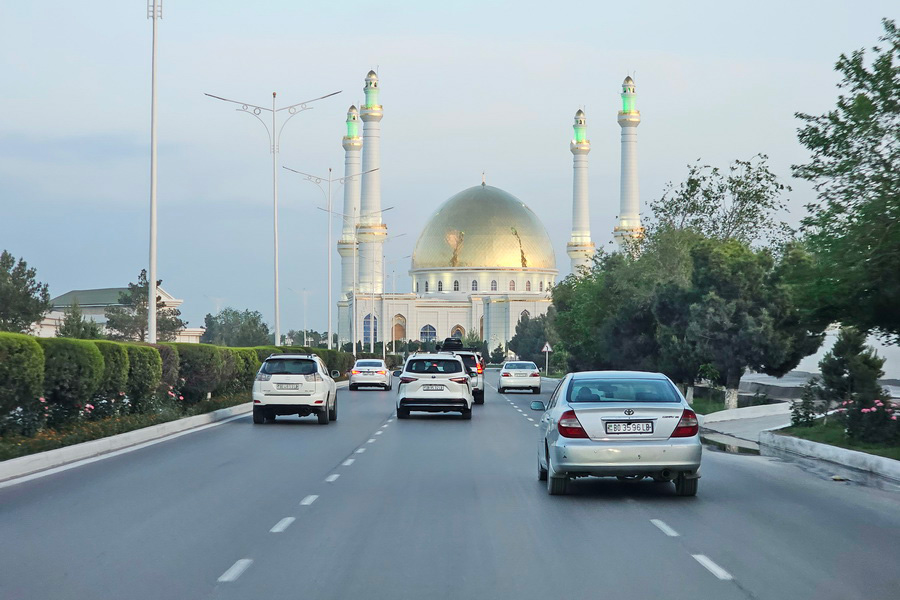Gurbanguly-hadji Mosque, Mary
Transiting through Turkmenistan in your own car offers a unique opportunity to explore one of the most mysterious countries in the world. A tourist visa to Turkmenistan is required for citizens of all nationalities and can be quite difficult to obtain. A transit visa, on the other hand, allows travelers to cross the country within five days, is slightly easier to secure, and does not require booking a tour through a local travel agency. In this short guide, you’ll find all the key details and important nuances of transiting through Turkmenistan in your own vehicle.
Transit Visa to Turkmenistan
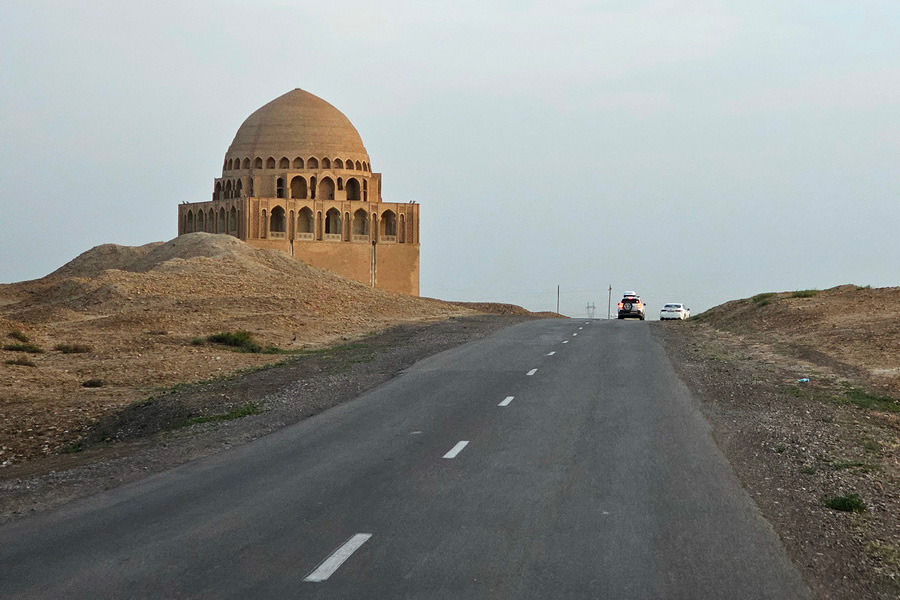 Sultan Sanjar Mausoleum, Merv
Sultan Sanjar Mausoleum, Merv
Until March 13, 2023, Turkmenistan remained closed to foreign visitors due to the COVID-19 pandemic. A tourist visa allows travelers to explore the country on any route and is typically issued for an extended period. However, the travel itinerary and entry/exit dates must be approved in advance, and a local guide or driver is required for the entire trip. A transit visa to Turkmenistan, by contrast, does not require a guide but limits the stay to five days and prohibits re-entry from the same country of origin. The most common transit route is Iran – Turkmenistan – Uzbekistan.
To apply for a transit visa, travelers must submit an application to the Embassy or Consulate of Turkmenistan in their country. Processing typically takes up to 15 days. The required documents and information include:
- A color copy of your passport and personal data;
- Planned dates of entry and exit;
- Detailed transit route with designated border crossing points;
- Contact information (telephone and email);
- Copies of valid visas for the countries of entry and exit;
- Completed visa application form with an attached photo.
If you are traveling in a privately owned vehicle, the owner must also provide the vehicle registration documents and a valid driver’s license.
Transit visas can only be issued at Turkmenistan’s embassies and consulates. They are not available at border checkpoints or at Ashgabat Airport. Please note that consular officials may deny a visa if they determine that transit is not justified. Applications are also frequently rejected if travel dates coincide with national holidays (such as March 21–23, May 9, May 18, September 27) as well as the religious holidays of Kurban Bayram and Uraza Bayram (dates vary each year).
The cost of a transit visa starts at $20, depending on duration and nationality. Expedited processing may cost up to $210. Additional border fees apply and are outlined below.
Border Crossing Points in Turkmenistan
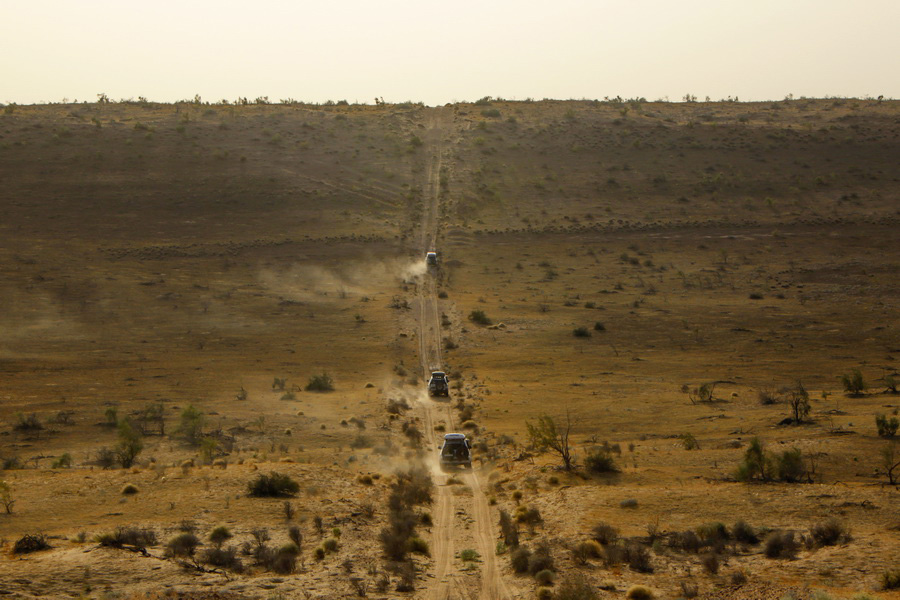 Road through the steppe, Southern Turkmenistan
Road through the steppe, Southern Turkmenistan
Turkmenistan shares land borders with Uzbekistan, Kazakhstan, Iran, and Afghanistan. Each of these borders has designated land crossings that operate from 9:00 a.m. to 6:00 p.m. A full list is available on the border crossing points page.
The most commonly used crossings for travelers:
- Farap – Alat*
Closest cities: Turkmenabat (Turkmenistan) and Bukhara (Uzbekistan) - Dashoguz – Shavat
Closest cities: Dashoguz (Turkmenistan) and Khiva (Uzbekistan) - Kunya-Urgench – Khodzheyli**
Closest cities: Kunya-Urgench (Turkmenistan) and Nukus (Uzbekistan) - Gaudan – Bajgiran
Closest cities: Ashgabat (Turkmenistan) and Shirvan (Iran) - Saraghs – Saraghs
Closest cities: Mary/Merv (Turkmenistan) and Mashhad (Iran)
*open 24 hours
** one-way: from Turkmenistan to Uzbekistan
For travelers driving SUVs through remote desert regions, the Garabogaz – Temir Baba crossing may be of particular interest. This checkpoint connects Kazakhstan’s Mangystau Region with the Caspian coast of Turkmenistan. However, keep in mind that the stretch between Zhanaozen and Turkmenbashi spans 415 km, and road conditions are poor in many areas.
While it is technically possible to enter Turkmenistan by ferry from Azerbaijan, we cannot recommend this option. Departure schedules depend entirely on vessel occupancy and other unpredictable factors, often causing delays of several days when crossing the Caspian Sea. It also involves additional costs, including the ticket price and a fee for transporting your vehicle. If you are prepared for possible delays and extra expenses, this transit route through Turkmenistan may still offer a unique and memorable experience.
Gasoline Surcharge and Other Transit Fees in Turkmenistan
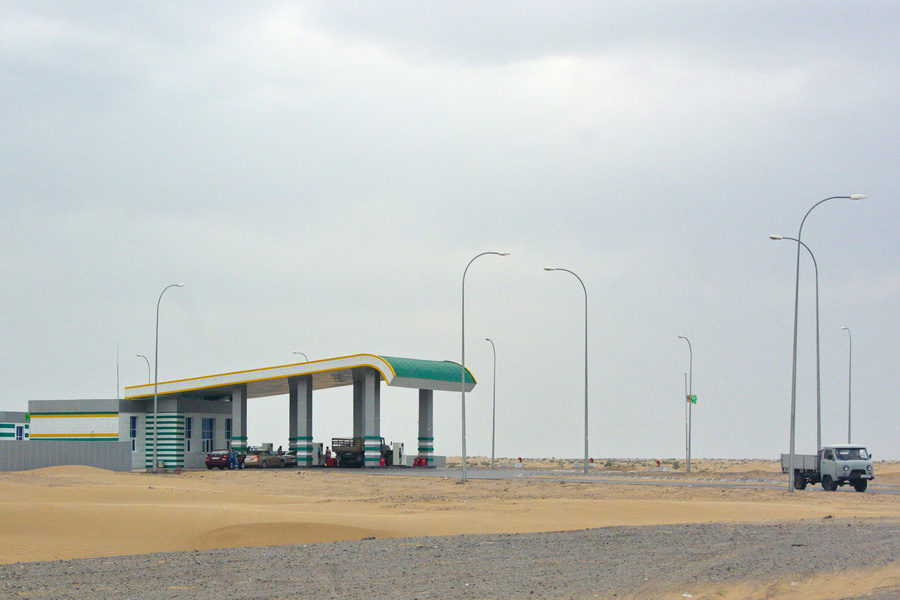 Last gas station on the way to the Darvaza crater
Last gas station on the way to the Darvaza crater
When transiting through Turkmenistan in your own car, be prepared to pay several types of fees: environmental, sanitary, border, road usage, and fuel charges. You will also need to purchase local insurance and obtain permits. All payments must be made on the spot in cash and in US dollars.
It is important to keep all receipts and invoices, as they may be required when exiting the country. Fuel and road insurance charges vary depending on your vehicle type and transit route. These fees are largely influenced by Turkmenistan’s low fuel prices – gasoline costs around 1.5 manats (approximately 43 US cents) per liter.
Due to this, refueling using canisters or other containers is strictly prohibited. Additionally, there have been reports that GPS trackers are installed on transit vehicles at border checkpoints to monitor distance traveled within the country.
The fuel charge is calculated at a rate of 0.2 US dollars per kilometer. For example, the longest transit route – Farap to Turkmenbashi, covering 1,200 kilometers – would cost approximately 240 US dollars.
Sanitary and quarantine fees are 5 US dollars each, the administrative fee is approximately 15 dollars, and the installation of a GPS tracker costs 20 dollars. Other charges depend on the type of vehicle. Additionally, travelers crossing the Farap–Alat border must pay a fee for using the bridge over the Amu Darya River.
| Type of vehicle | Entry permit (USD)* | Liability insurance (USD)* | Bridge over the Amu Darya (USD)* |
| Motorbike | 30 | 15 | 10 |
| Car (incl 4x4) | 67 | 35 | 10 |
| Pick up/car with trailer | 76 | 45 | 10 |
| Minibus (up to 12 seats) | 76 | 45 | 50 |
| Bus (13-30 seats) | 111 | 45 | 50 |
| Bus (>30 seats) | 163 | 45 | 50 |
| Track (up to 10 tons) | 130 | 100 | 40 |
| Track (up to 20 tons) | 180 | 100 | 60 |
| Track (>20 tons) | 250 | 100 | 80 |
*Rates are current as of May 2025.
Overall, the total cost of transiting through Turkmenistan in your own car typically ranges from $250 to $400 or more, excluding the visa fee.
How to Transit Through Turkmenistan: Essential Tips and Advice
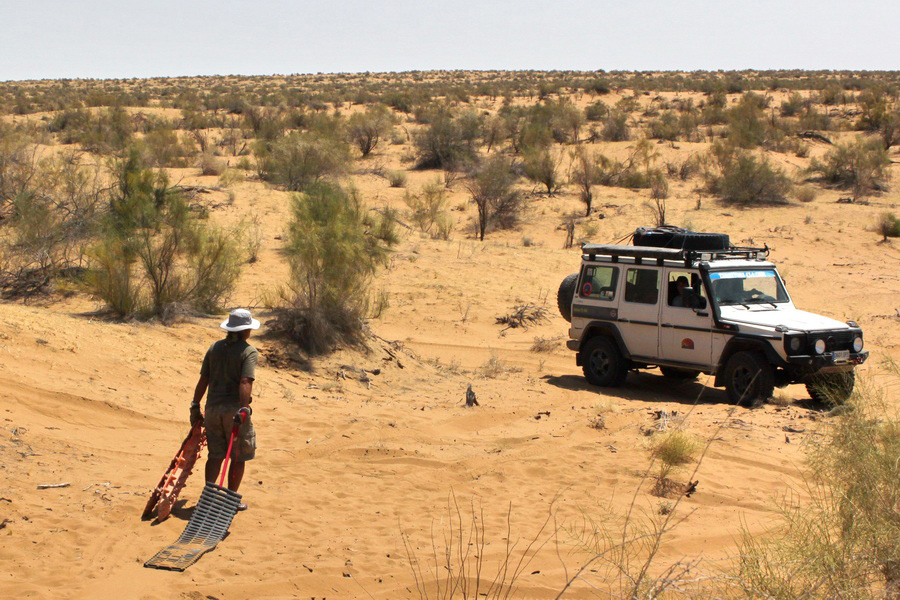 Road across the sands of the Karakum Desert
Road across the sands of the Karakum Desert
To transit through Turkmenistan in your own car, you will need your driver’s license and the vehicle registration certificate. No translations are required – original documents are sufficient. However, it is recommended to carry several copies of these documents. If you plan to switch drivers during the trip, power of attorney documents are required for all potential drivers other than the vehicle owner.
Plan to arrive at the border as early as possible. Turkmenistan’s border checkpoints open between 8:00 and 9:00 a.m., and the entire crossing process can take several hours. If border officials conduct a full inspection or if there is a long queue, the procedure may last most of the day. Keep all receipts and payment documents for fees, and do not attempt to bypass official charges - proof of payment may be required when leaving the country.
Most of Turkmenistan is accessible by car. However, if you plan to visit remote attractions like Yangiqala Canyon or the Darvaza gas crater, an off-road vehicle is necessary. Both sites are located in the Karakum Desert, and independent trips should be planned carefully.
Large parts of the country are desert, with hundreds of kilometers between settlements, often without shops or fuel stations. From April to October, temperatures can exceed 40°C, even in spring. Check your vehicle regularly, protect the engine from overheating, and refuel whenever possible. It is advisable to carry extra drinking water and snacks for long journeys.
Speed limits in Turkmenistan are 60 km/h in cities, 90 km/h outside urban areas, and 120 km/h on highways. Police may stop drivers for minor speeding. In Ashgabat, dirty vehicles are not tolerated, cars may be stopped simply for their appearance, so it is best to visit a car wash before entering the capital. In other areas, police usually stop vehicles only to check documents.
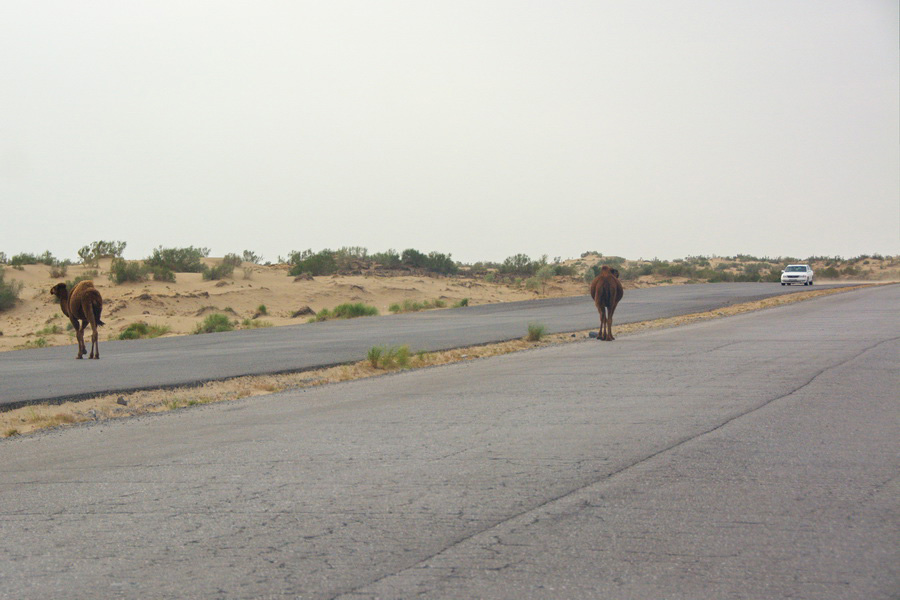 Camels on the Ashgabat–Dashoguz highway
Camels on the Ashgabat–Dashoguz highway
Avoid driving outside cities at night. Camels often roam freely in the desert and are difficult to see in the dark. Due to their size and height, a collision can be fatal. If night driving is unavoidable, reduce speed and drive with extreme caution.
In Turkmenistan, SIM cards can only be purchased at TM CELL offices. Internet access in the country is limited, and social media platforms are not available. It is recommended to download offline maps of Turkmenistan in advance to use for navigation during your trip.
Optimal Transit Routes Through Turkmenistan
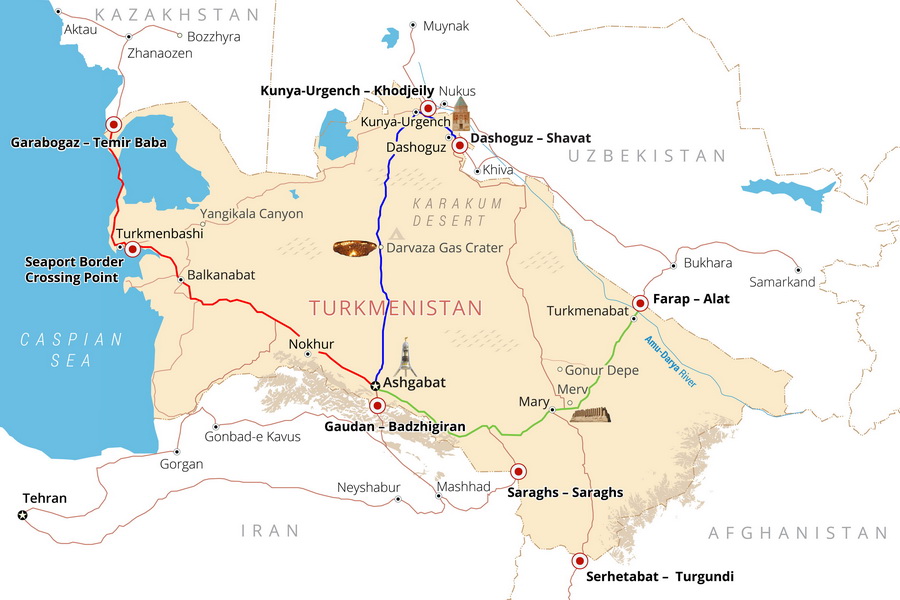 Map of Transit Through Turkmenistan in Your Own Car (Download Large Map)
Map of Transit Through Turkmenistan in Your Own Car (Download Large Map)
If you want to do more than simply cross Turkmenistan and would like to experience its landscapes and historical sites, there are several routes that allow for sightseeing within the five-day transit visa period. These options follow relatively direct paths through the country and are generally acceptable to consular officials, as they do not involve significant deviations from the main route.
Central Route via the Darvaza Gas Crater
After entering Turkmenistan at the checkpoint near Nukus or Khiva (Uzbekistan), the route begins with a stop in the ancient city of Kunya-Urgench, which can be explored in a few hours. Overnight accommodation is available in Dashoguz. The next day, continue to the Darvaza gas crater, where you can stay overnight in a nearby yurt camp. On the third day, head south to Ashgabat, the capital. On the fourth day, complete your transit by crossing into Iran.
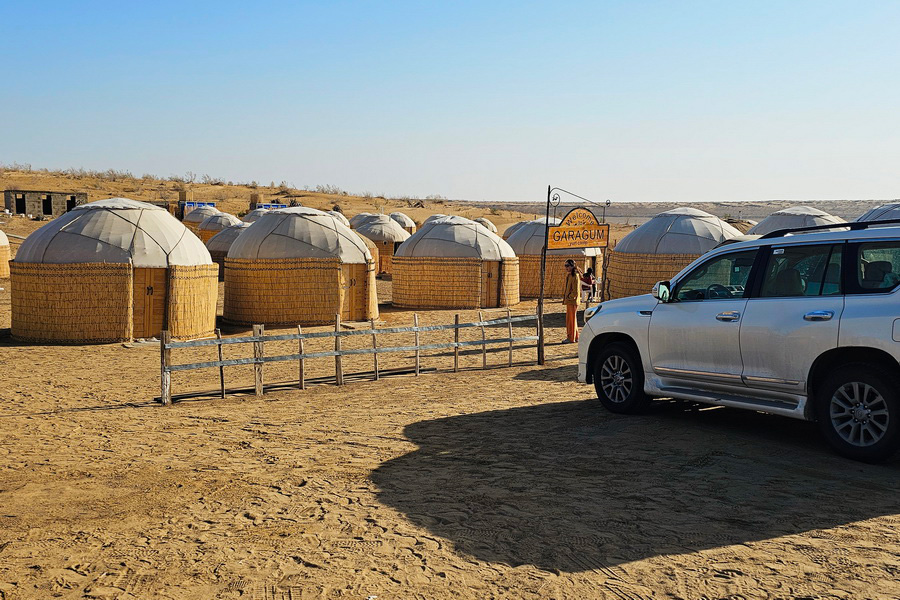 Yurt camp near the Darvaza crater
Yurt camp near the Darvaza crater
Eastern Route via Ancient Merv
Departing from Bukhara (Uzbekistan) in the early morning, cross into Turkmenistan via the Farap–Alat checkpoint and travel across the Karakum Desert to Mary, where you can spend the night. The following day, visit the archaeological site of ancient Merv, then continue on to Ashgabat. The third day can be used to explore the capital or visit nearby sites such as Old Nisa and the Kov-Ata cave. On the fourth day, take a short morning walk around Ashgabat before heading to the Iranian border.
Western Route via Turkmenbashi
After exploring the Mangystau region of Kazakhstan, overnight in Zhanaozen before proceeding to the Turkmen border the next day. The drive continues through remote areas to Turkmenbashi, where you stay overnight. On the second day, visit the colorful landscapes of Yangikala Canyon, then continue to Balkanabat for the night. The third day includes the journey to Ashgabat, with stops at Geok-Tepe, Kov-Ata, and Nisa along the way. The fourth day ends with the border crossing into Iran.
 At the viewpoint of the Yangykala Canyon
At the viewpoint of the Yangykala Canyon
Although it is possible to transit Turkmenistan in just two days, extending your journey across the full five-day visa period allows for a more rewarding experience. Additional routes and border checkpoints between Turkmenistan and Iran may also be used, depending on your travel goals. For a deeper exploration of this little-visited country, consider booking a guided Turkmenistan tour.


